Hey, AveeBee here. This is my first time writing a development diary for you all, having only joined the Hearts of Iron team earlier this year. However, I’d just like to say that it’s a great honor to get to do this having been a fan of the series for literally decades at this point, (yeah, look it up, Hearts of Iron I came out in 2002, crazy right?) I’m really excited to be contributing to this awesome game. With that out of the way, let's once again dive into Ethiopia!
As explained in the
{LINK REMOVED}last Ethiopian dev diary, Ethiopia starts in a dire situation with the Italian invasion of the country well under way and any hope of winning the war rapidly diminishing. Haile Selassie historically left the country to rally support through the League of Nations for stopping Italy’s illegal invasion. But Haile Selassie wasn’t the only one in Ethiopia with ideas on how to end the war…
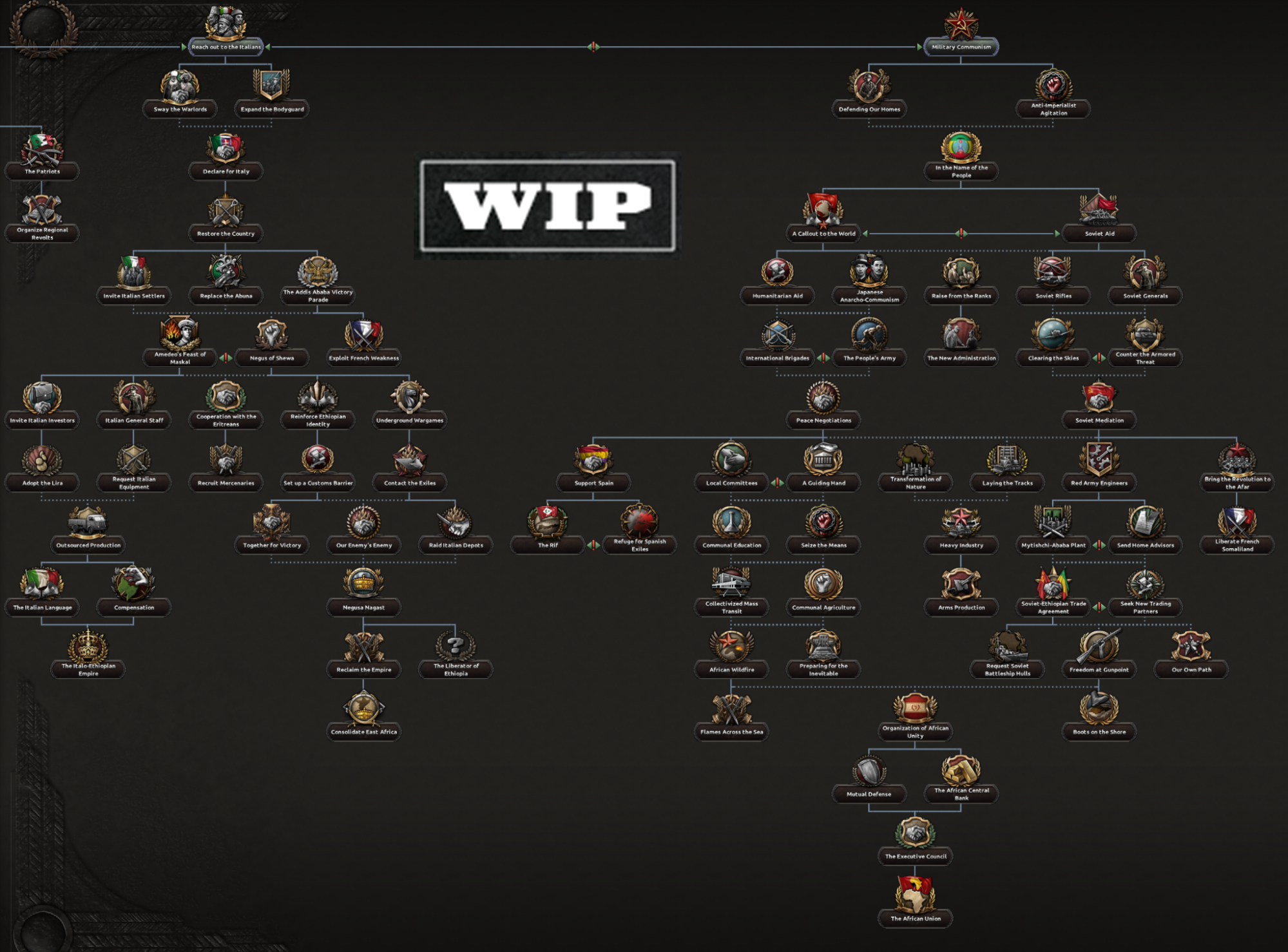
Let’s wind back the clock to early 1936, before Selassie leaves the nation for Geneva. In such desperate times, there are rumblings of discontent with the emperor’s handling of the conflict. Among the regional aristocrats, there is talk of reaching out to the Italians and switching sides in the hopes of maintaining hereditary titles. Meanwhile, the troops grow ever more disgruntled with officers leading them into defeat after defeat, knowing well that they were only given their ranks by birth right. Behind enemy lines, the fierce anti-fascist Black Lions begin to wonder if their successes and sacrifices are having any impact on the war as the Italians continue to push deeper and deeper into the heart of Ethiopia.
With so many disgruntled factions, the slightest nudge can drastically alter the structure of the empire.
Facist Path Let's start by looking at the fascist sympathizing aristocrats. Starting at the top of their focus branch, we have
Reach out to the Italians. This focus puts the feelers out to see whether the Italians would be willing to support a coup against Selassie in exchange for letting them maintain some level of control once the dust finally settles. This focus also determines who will be the leader of the revolt against Selassie. As can be seen from the icon, there is a choice of three potential leaders, Haile Selassie Gugsa, Hailu Tekle Haymanot of Gojjam and Abba Jofir of Jimma. Each leader has different strengths and weaknesses and will move the power center of the country to their respective regions, should they succeed in overthrowing the emperor. Unfortunately the portraits for these guys aren’t complete, yet so I can’t show them off today.
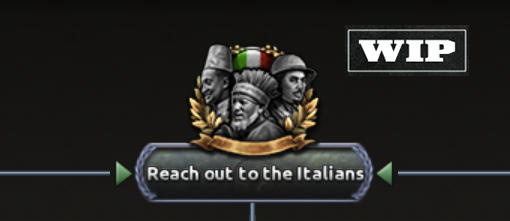
Should the Italians rebuff your attempts to reach out to them, the focus tree will unlock the first section of the historical/imperial branch and the fascist sympathizing aristocrats will have to swallow their ambitions and do as the focus says, Rally around the Emperor. The decision to lock the player in this path in such a scenario is due to the importance of time for Ethiopia as it is immediately at war with Italy. Italy’s decision to accept the proposal will be weighted on how close they are to defeating Ethiopia and the war escalation levels mentioned in the last Ethiopia dev diary. For instance, if the war is dragging on for Italy, the odds of them accepting the deal will increase. Meanwhile, if Ethiopia is close to capitulating, Italy will be less likely to accept the deal.

However, if the Italians are receptive to the idea of Ethiopia tearing itself apart, the next two focuses, Sway the Warlords and Expand the Bodyguard will be available. Swaying the warlords will boost the popularity of fascism in Ethiopia and give access to loyalist generals once the current war is won. Meanwhile expanding the bodyguard will guarantee a number of elite divisions will be loyal to their Italian backed leader when the empire inevitably fractures.
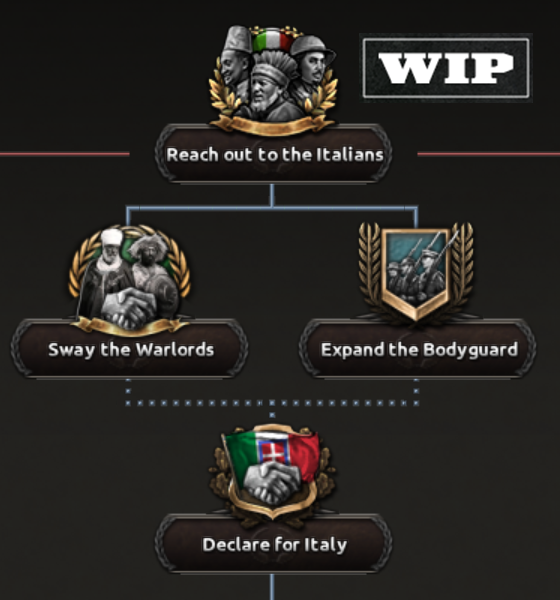
Once the fascists have built their support network up, it’s time for them to Declare for Italy. Once this focus is taken, the fascist supporters will break away from Ethiopia to become an Italian puppet. Who that puppet is will depend on which leader was chosen to reach out to the Italians. With the backing of the Italians, it won’t take long to defeat the diminished forces still loyal to Haile Selassie and finally bring ‘peace’ to the region.
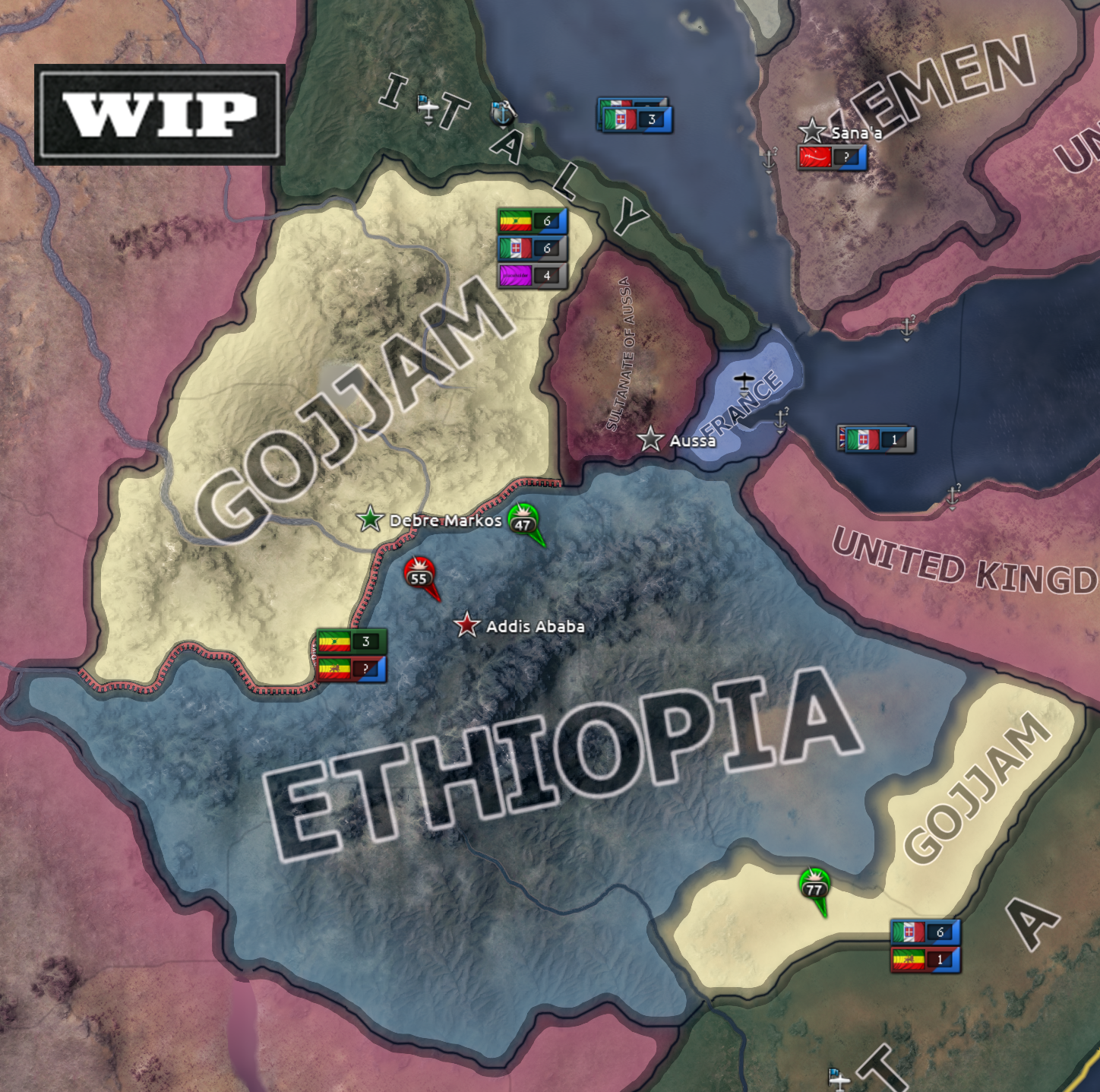
Once the civil war is over, what was once Ethiopia will be in tatters and under the yoke of Italian rule, as can be seen by the ‘Victor Emanuel I’ national spirit and the loss of some territory. But while it might otherwise have been annexed completely into Italy, the former empire retains a semblance of independence under the watchful eye of its new fascist leader. The initial objective after the war is of course rebuilding the damaged infrastructure and generally strengthening the reorganized rump state. There are of course the general economic and military branches explored in the last DD available at this point, however there are also bonuses for rebuilding that are unique to the fascist path too.
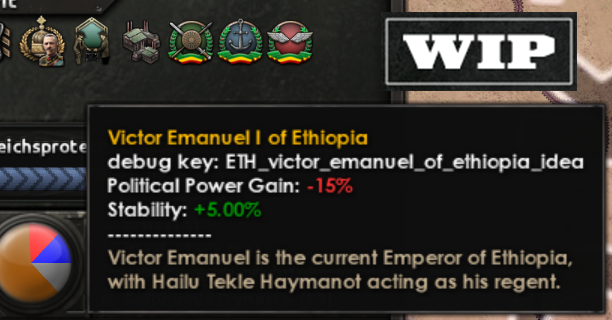
After completing Rebuilding the Country, we have a few options to take. Each of them begins the transition of moving Ethiopia away from a traditional empire and more towards a nation united under a leader with absolute authority. Replace the Abuna allows the removal of Qerellos IV from leadership of the Ethiopian Coptic church and the ability to replace him with someone more… loyal to the new order.
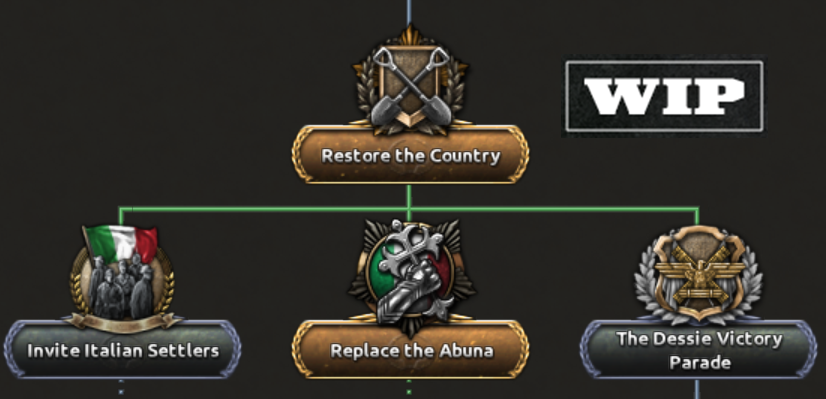
The Victory Parade gives the people of the capital a chance to thank their supposed savior for preventing the destruction of the nation. This also has the added effect of boosting the country leader’s stats, depending on who was chosen of course.
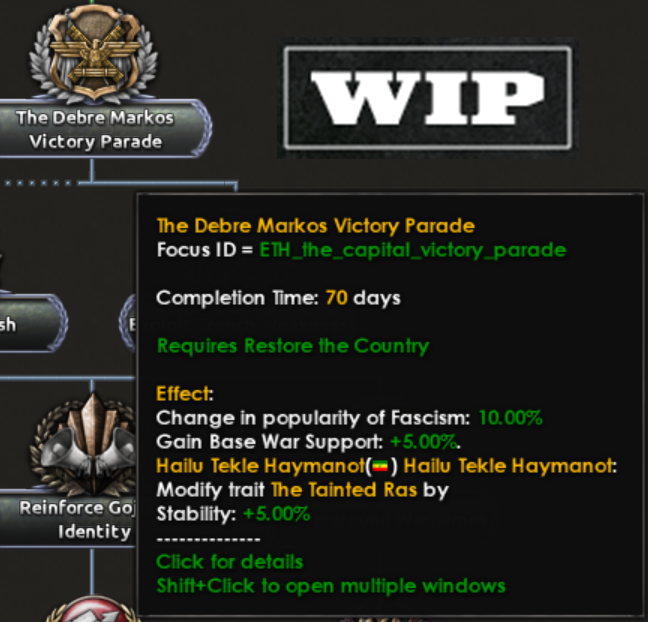
To the left we have Invite Italian Settlers which does exactly what it suggests. This adds the Italian Settlers national spirit to Ethiopia which gives massive boosts to construction and population growth. It also converts two pastoral states into rural states, as new Italian settlements in the countryside begin to take shape. However, this all comes at the cost of reducing Ethiopia’s effectiveness at fighting the Italians due to their people and culture becoming intermingled with its own.

This is also the point at which choices must be made over the future of Ethiopia. Will it be a loyal and indispensable subject of Italy? Or will it make schemes in the shadows for the eventual restoration of independence? It might seem like an easy choice, after all, who wants to be a puppet right? However, as mentioned above with Invite Italian Settlers there are advantages to getting cozy with the Italians.
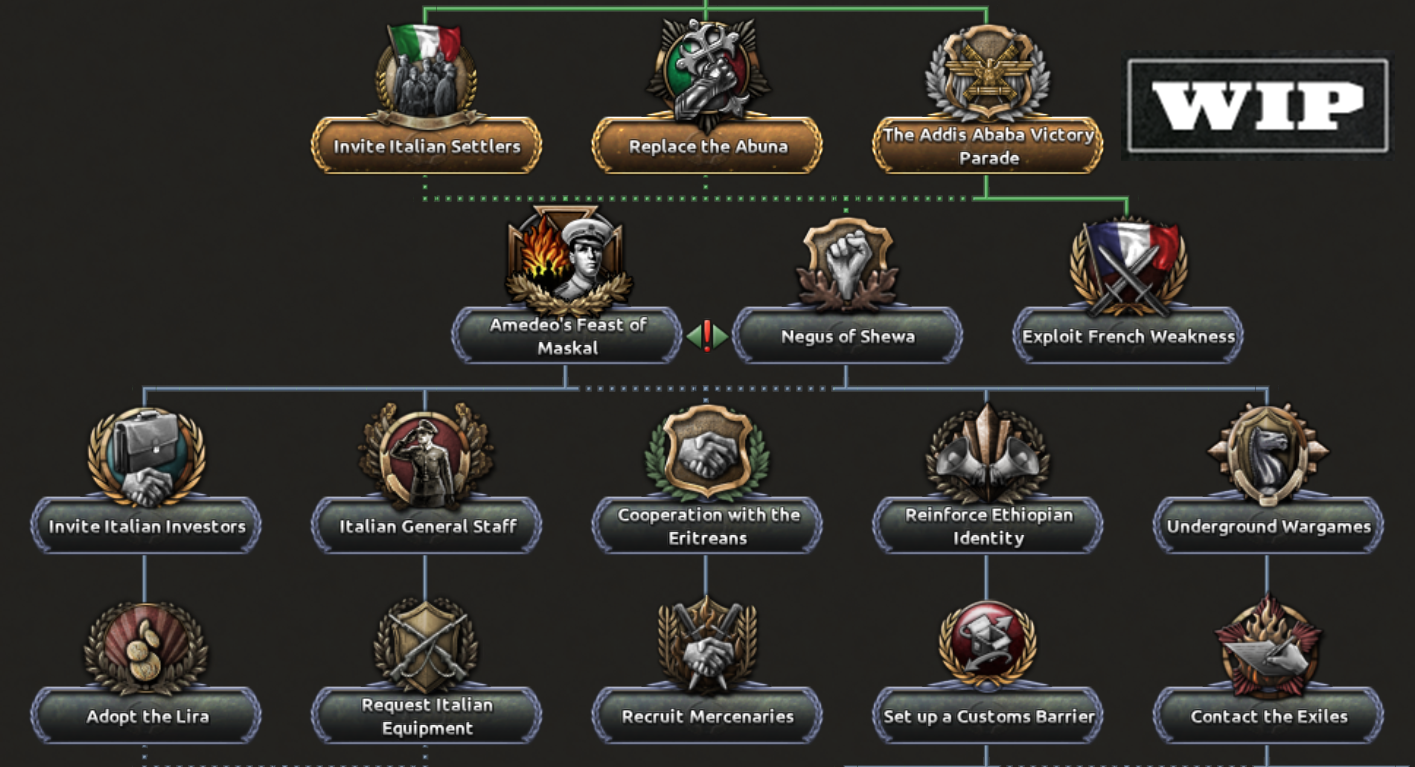
Lets see what those advantages are by exploring the collaborationist path first. In order to gain the Italians’ trust, Ethiopia’s leader will have to secure support from the regional governor of East-Africa, Prince Amedeo. And what better occasion to do so than the feast of Maskal! Trivia time, this meeting actually happened during Italy’s occupation of Ethiopia as the Italians attempted to secure control of the region by courting the remaining Ras’ (Ethiopian aristocracy). The Feast of Maskal is a celebration performed by followers of the Ethiopian Orthodox Christian church celebrating the discovery of ‘the True Cross’ in the 4th century by Queen Eleni.
Back to our alternate timeline, as mentioned earlier on, when taking the Sway the Warlords focus a number of military officers will pledge themselves to the new fascist order. Now when taking the Feast of Maskal focus, these officers will become available again. On top of that, the Victor Emanuel I national spirit will also gain some boosts to make him less negative to Ethiopia.
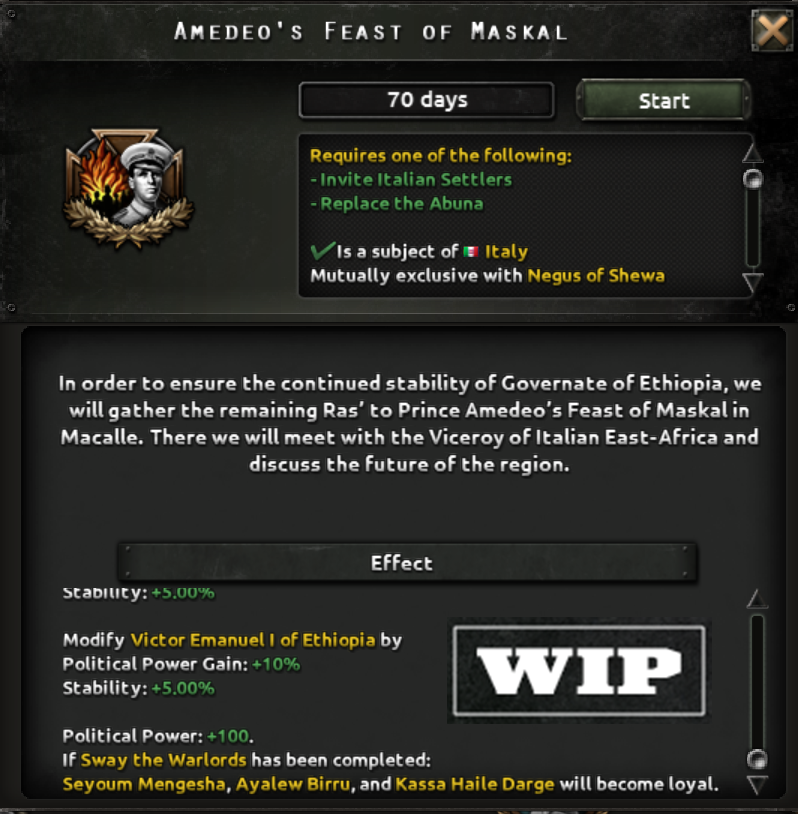
Following this, we have a number of focuses to take advantage of Italy’s military experience and sweet, sweet industry for the benefit of Ethiopia. On the economic side, the nation can gain extra civilian industry by Inviting Italian Investors and Adopting the Lira. On the military side, Ethiopia can recruit Italian General Staff to act as advisors or gain some infantry equipment and artillery via the Request Italian Equipment focus. At the neck of this branch, Ethiopia can utilize an array of Italian design companies via the Outsourced Production focus.

Following this, we have a number of focuses to take advantage of Italy’s military experience and sweet, sweet industry for the benefit of Ethiopia. On the economic side, the nation can gain extra civilian industry by Inviting Italian Investors and Adopting the Lira. On the military side, Ethiopia can recruit Italian General Staff to act as advisors or gain some infantry equipment and artillery via the Request Italian Equipment focus. At the neck of this branch, Ethiopia can utilize an array of Italian design companies via the Outsourced Production focus.
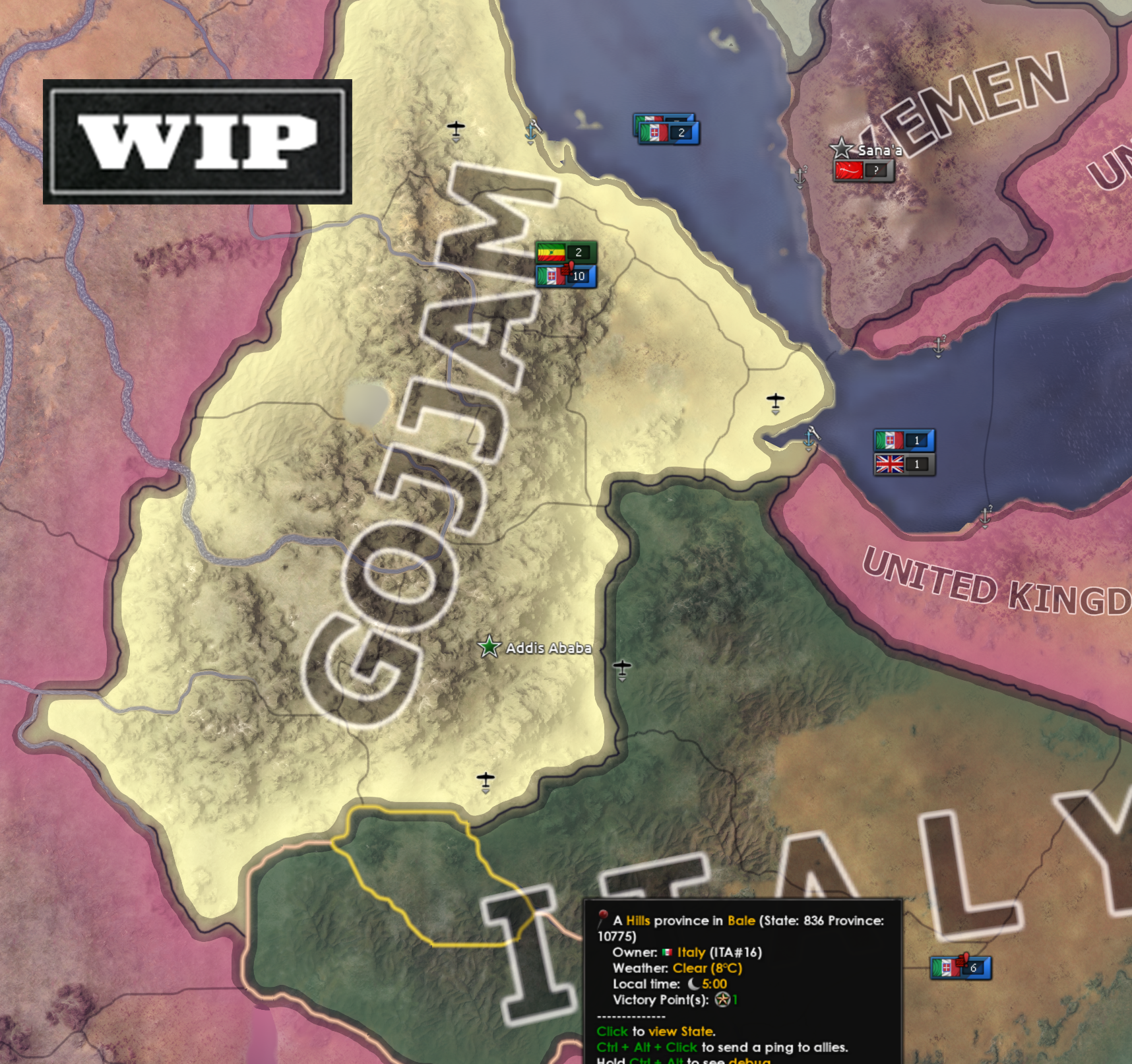
But at the very end, the big finale for towing the Italian line is the recognition of Ethiopia as a loyal partner to Italy rather than a simple colony. This culminates in the formation of the Italo-Ethiopian Empire in East-Africa and the unification of what was once two separate crowns. And as a goal for the reformed empire, it also gains the Arranged Expansion idea which will transfer control of conquered lands in the region to Ethiopia.
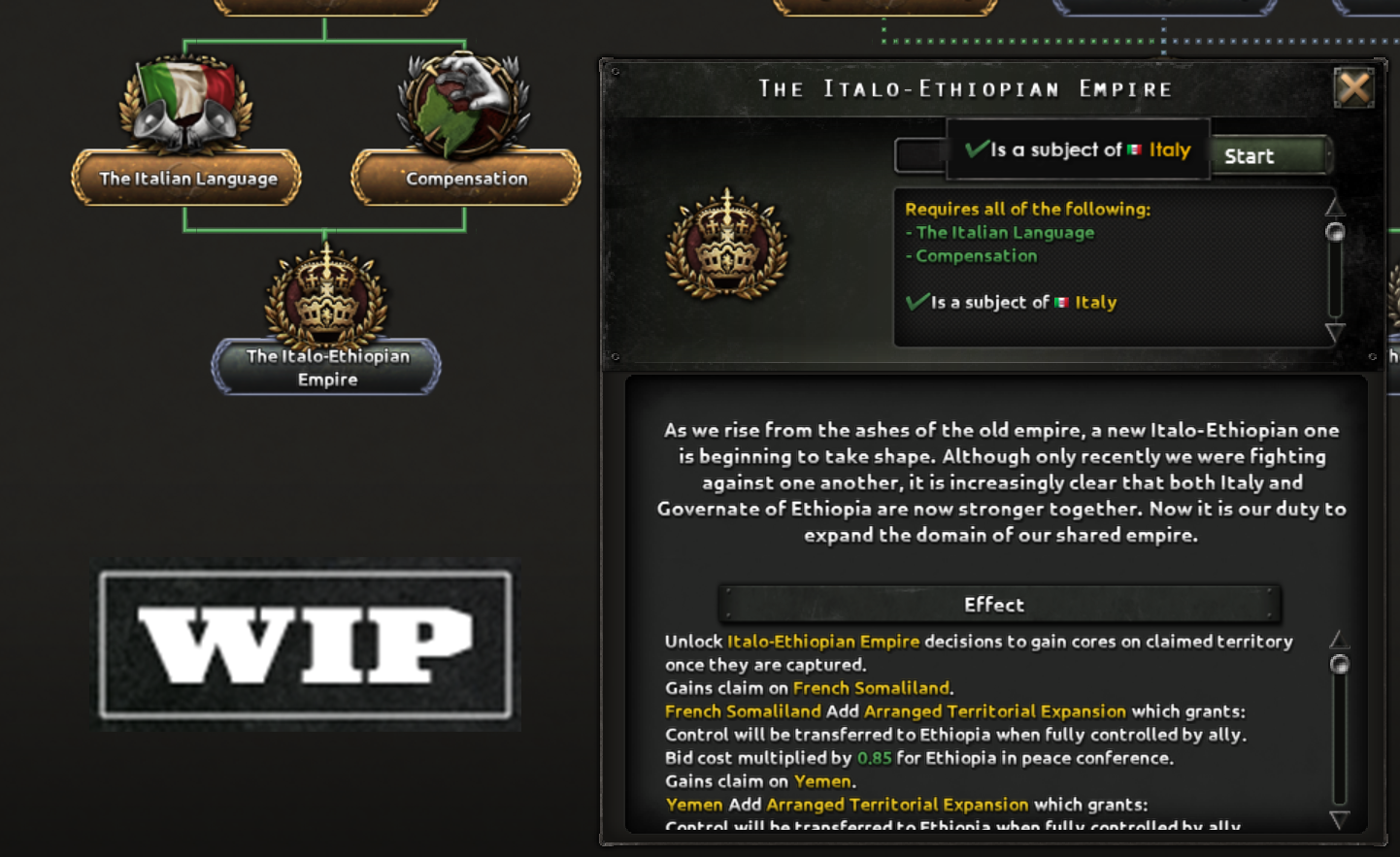
So, we’ve explored what loyalty gets you, now let’s see what betrayal gets you! If we go back to the Feast of Maskal focus, you might have noticed it is mutually exclusive with the Negus of Shewa focus. This focus sets Ethiopia on a collision course with Italy by rejecting their influence and rekindling pride in the nation once again. This will cause the Victor Emanuel I national spirit to become detrimental to Ethiopia’s stability as the people reject the new sovereign. Reinforce Ethiopian Identity builds on this further by increasing support for going to war as the people rekindle their fighting spirit.
If the new regime intends to fight the Italians, then they must prepare the military. Luckily, taking the Underground Wargames focus will give the troops a substantial advantage when engaging the Italian military. While the collaborationist branch is focused on integrating into the Italian economy, this branch is more about being the absolute worst subject possible. Options for doing this include Set up a Customs Barrier which allows Ethiopia to make trade with Italy as difficult as humanly possible while still avoiding the Regia Marina resorting to gunboat diplomacy. This protectionist measure will give Ethiopia an economic boost, while reducing Italy’s colonial gains from its unruly puppet. If that isn’t good enough of an insult to the Italians, there’s also the option to Contact the Exiles who fled Ethiopia and have them return with foreign weapons for the troops.
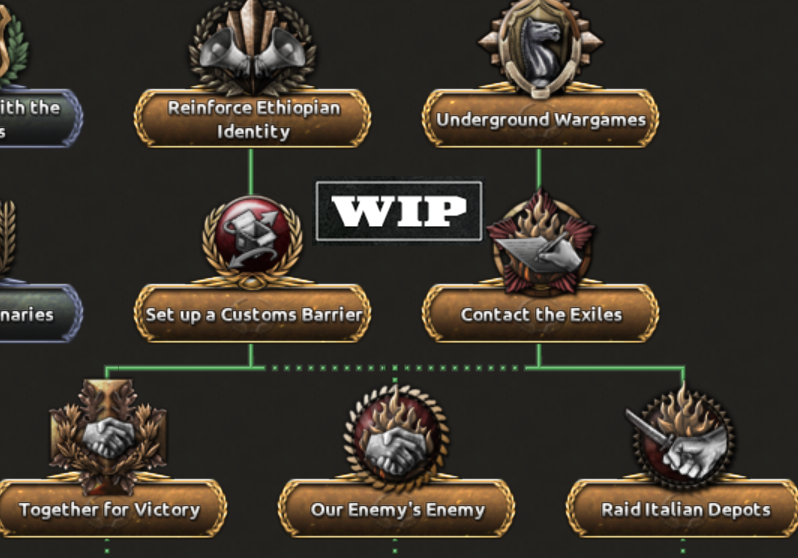
Due to the lack of economic support by following this sub-branch, Ethiopia is going to be much more reliant on foreign aid if it is to succeed in driving Italy out of the country. Luckily, there’s usually not a shortage of nations who would like to see Mussolini knocked down a notch or twelve. This can be utilized by Our Enemies Enemy, which allows the other great powers to send military equipment to Ethiopia.
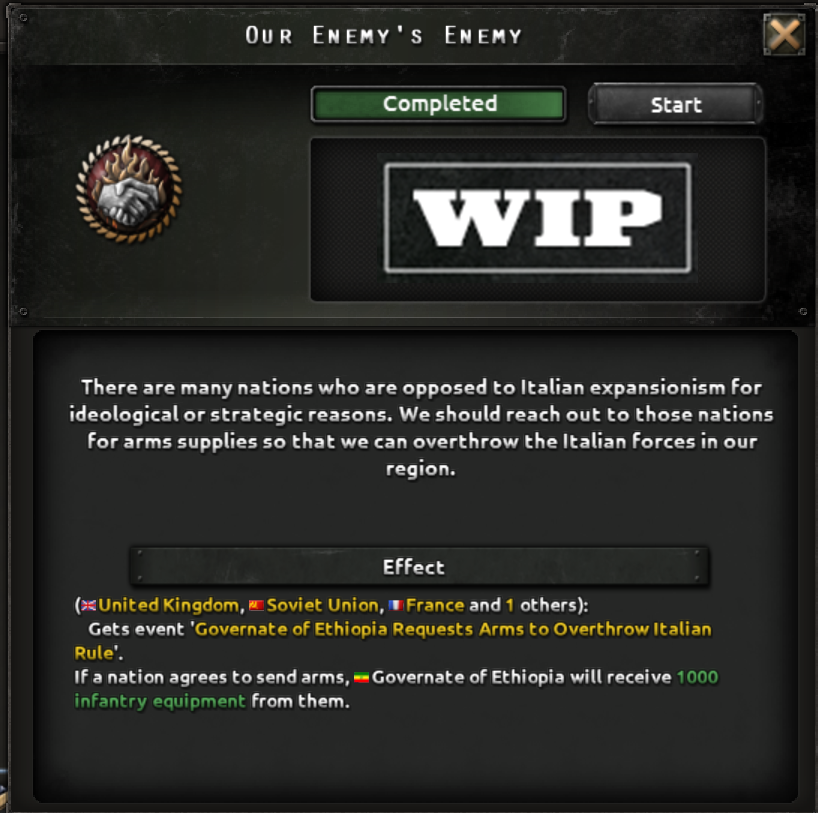
Another fun way to make the Italians hate you is to raid their depots for equipment and destroy what you can’t carry. Sounds fun right? Luckily we have a focus that lets you do exactly that! Raid Italian Depots will trigger a number of raids over the following months which increase Ethiopia’s stockpile of weapons while increasing Italy’s supply consumption.
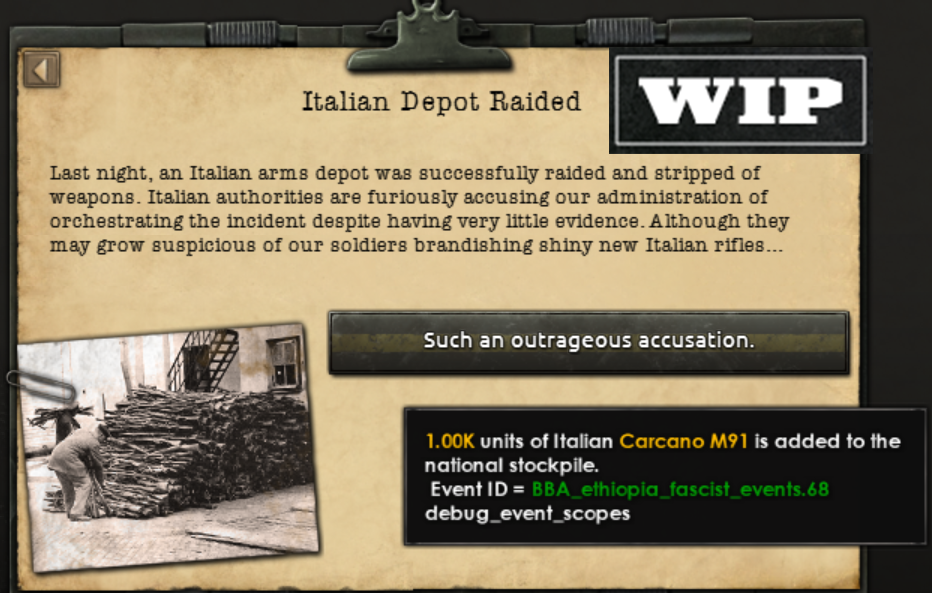
But, what’s a revolt without friends, am I right? Together for Victory allows Ethiopia to reach out to the various resistance groups in East-Africa who are opposed to Italian rule. If conflict breaks out between Ethiopia and Italy, these resistance fighters will take up arms behind enemy lines and join the conflict alongside Ethiopia.
Once Italian rule in Ethiopia has been sufficiently weakened and the underground army is ready to leap into action, it is time to declare independence and prepare for the backlash. Negusa Nagast is the focus that allows Ethiopia to do exactly that, but it shouldn’t be taken lightly. If Italy is stubborn enough, they may come down hard on this rebellion, but hopefully preparations made earlier will tip the balance in Ethiopia’s favor.
Even if the Italians are too busy dealing with conflicts elsewhere, they may still be in control of land that is rightfully Ethiopian, which leads me to the next focus. Reclaim the Empire allows Ethiopia to regain cores on territory earlier ceded to Italy, once they are back under Ethiopian control. So, the new emperor has made it this far, apparently saving the empire on multiple occasions through various levels of back stabbing and insurrection. But what now? What is there to do for a newly crowned, backstabbing, insurrectionist of an emperor once he has gained his throne? Probably subjugate everything in the vicinity right? Great, because the final focus of this sub-branch, Consolidate East-Africa, gives Ethiopia claims on territory across the region and the ability to core them once conquered.

The collaborationist and independent fascist paths will hopefully offer a lot of replay-ability as the various choices throughout the two sub-paths make for various different narratives. Since the last dev diary, we’ve had a lot more great artwork added into the game for focus trees and events. Here’s an overview of the fascist branch at the moment, but remember that this is still a work in progress and may be subject to change.
Now, you might be thinking, ‘I’m fed up with this aristocratic stuff, this ain’t CK III!’ Well, fascism isn’t the only alternate history path for Ethiopia. Let's wind back the clock again to 1936. As mentioned earlier, there are rumblings from the front and in the streets, it’s not only the aristocracy that are growing frustrated with Haile Selassie’s leadership. The people and the troops are questioning the centuries old aristocracy and turning to the likes of the Soviet Union for inspiration.
Communist Paths This branch starts off with the focus Military Communism which will rally the troops on the front line and get them thinking about alternative systems of government. This starting point for the communist path was influenced by the types of movements that sprung up in Africa during the Cold War which often centered around the military acting as a vanguard party to overthrow the old order. In this timeline, we’re seeing that a little earlier due to the bleak position Ethiopia is in during 1936 and the memory of Russia’s 1917 October revolution still being fresh in the minds of people during the time period.
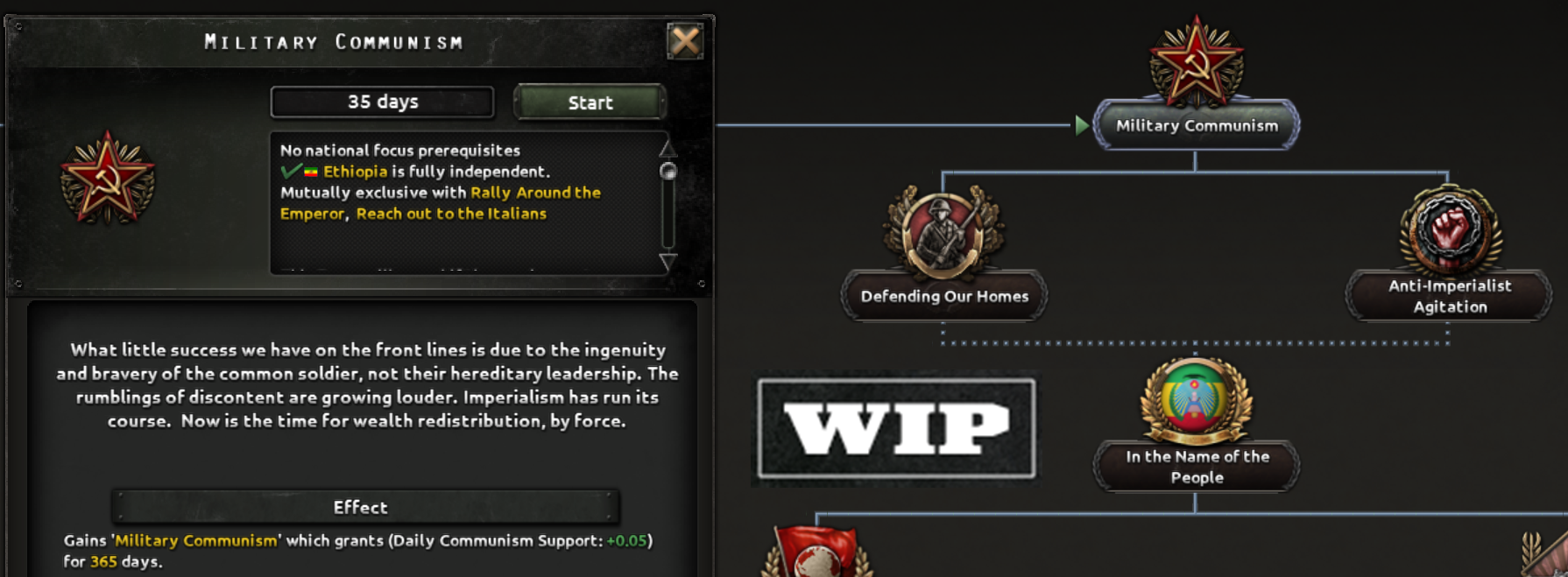
Now, the military isn’t the only place where communist influence is spreading during this time period. The Black Lions were an anti-fascist resistance movement in Ethiopia during the Italo-Ethiopian War and some members struggled on even after the country surrendered. While historically the Black Lions were mainly focused on anti-fascism and independence for Ethiopia, a number of members of the Black Lions were supposedly communist leaning. So alongside the spreading of communist thought among the military we also wanted to explore the what if scenario of the Black Lions, with all their skills and organization as resistance fighters, becoming increasingly disillusioned with the imperial system too.
Following on from this, we have Defending our Homes which grants defensive bonuses on core territory as the troops become desperate to prevent the destruction of their homeland. We also have Anti-Imperialist Agitation which adds a wave of communist support as more and more people turn their backs on the failing imperial system. In order to progress beyond this point of the branch, Ethiopia needs at least 20% support for the communists. As mentioned earlier, Military Communism is based around the military forcing a communist revolution rather than the types of mass movements that have started them in other countries. But while 20% support may seem low, it’s worth remembering that the Italians will be steadily chipping away at your territory, so even getting to this threshold can be a real race against time.
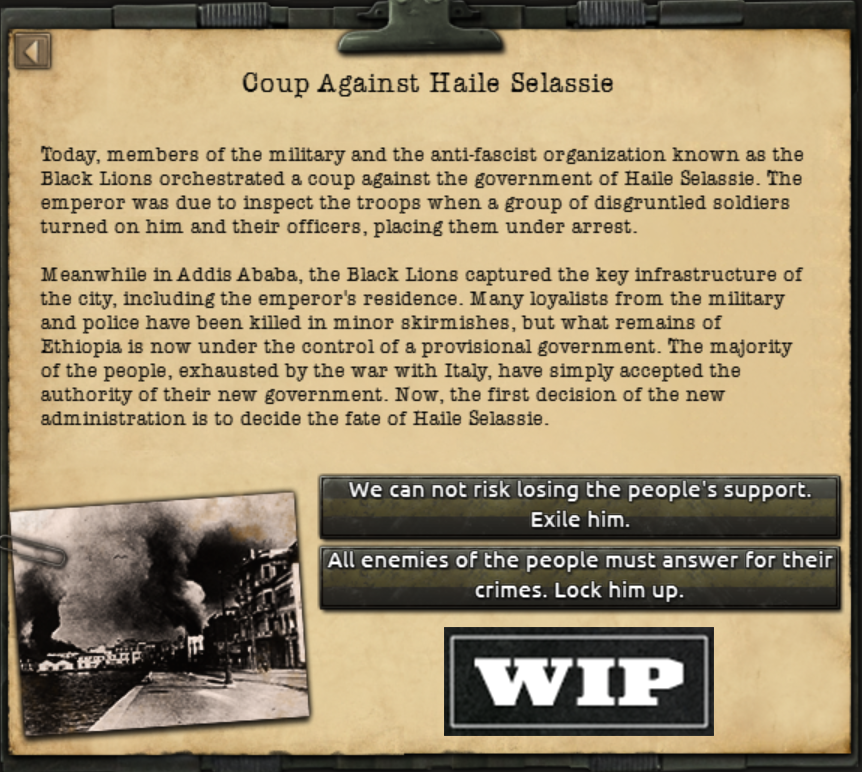
Once there is enough support for the communists, the next focus in the branch In the Name of the People will become available. This focus, as you might expect, triggers a coup against the government of Haile Selassie. The Black Lions and members of the military will arrest the emperor and form a provisional government. At the head of this provisional government is Alemework Beyene, the chairman of the Black Lions. From the offset of this provisional government, relations will be strained between the military communists and the Black Lions. The Black Lions’ constitution places the political sphere above the military and enshrines the rights of peasants, while those in the military believe they alone can govern Ethiopia in this time of crisis. This instability will be a key issue going forward.
Due to the dire situation brought on by the Italian invasion, the two political factions are forced to cooperate. For the time being anyway. During the coup, Black Lion and Red Guards divisions will become available to help maintain a smooth transition of power and to back up the beleaguered troops on the front line. With control of Ethiopia established, the first major decision to make is how to continue the fight against Italy. The Black Lions advocate for A Callout to the World which will set Ethiopia on a course to rally support from anti-fascists across the globe.

Meanwhile the military communists believe the only real hope of victory lies in gaining the support of the Soviet Union. Let’s start by looking at the Soviet sub-branch which starts with Soviet Aid. This focus gives the Soviets the option to support Ethiopia with volunteers and opens the door to future cooperation. The well equipped Soviet divisions and air force make a massive difference in turning the tide against Italy. Following on from this, there are options to request more Soviet material support in the form of rifles, aircraft and armored vehicles. Or there’s the option to invite experienced Soviet generals to lead your armies. Of course the downside to this decision is that your own officers are not gaining experience, but sometimes desperate times call for desperate measures. As the country becomes increasingly influenced by the Soviets, Alemework Beyene and the provisional government will be ousted to be replaced with the military administration of Ethiopia.
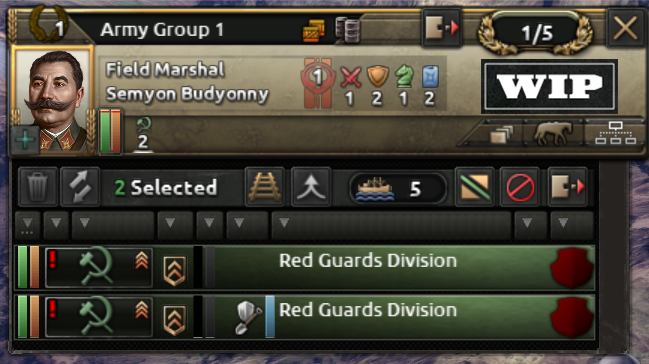
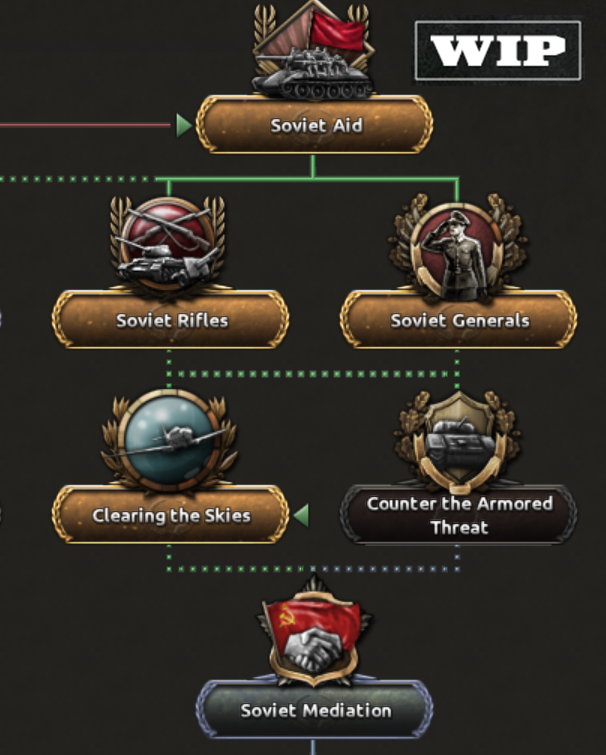
With the tide of war shifting and the Italian invasion brought to a halt by the combined efforts of Ethiopia and the Soviet Union, it’s time to start thinking of a way out of the conflict. This is where the focus Soviet Mediation comes in. This focus will prompt the Soviet Union to demand Italy withdraws to pre-war borders in East-Africa, or suffer the wrath of the Red Army. There’s a game of chicken here though, depending on the strength of both nations, Mussolini may call Stalin’s bluff and Stalin may back down. Or Mussolini might think Stalin is bluffing and quickly find the Red Army on the march. For Ethiopia, this is somewhat of a win-win scenario however as it is already at war with Italy. So it either gets peace or a strong ally in the ongoing conflict.
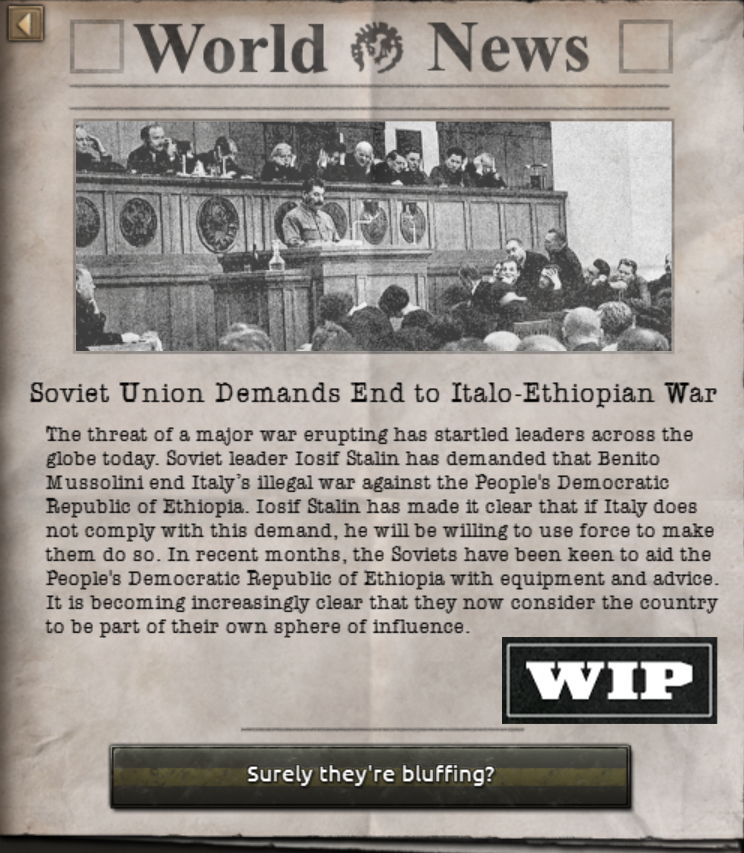
All of this support from the Soviet Union of course doesn’t come for free. Uncle Joe is going to want you firmly in the Soviet sphere of influence going forward, which means becoming a puppet. At least for now. Similar to the fascist branch, there are benefits to being a puppet but it doesn’t necessarily have to be permanent either...

With the revolution in Ethiopia finally secure, it is time to start building a glorious workers republic. Luckily, Soviet Engineers are on hand to support reconstruction efforts. Here, we have a few mutually exclusive choices depending on priorities. Taking advantage of being a puppet of course comes at the cost of autonomy but gives access to Soviet design companies and factories via the Mytishchy-Abba Machine Plant and Soviet-Ethiopian Trade Agreement. But there’s also the option to push back against Soviet influence by dismissing their advisors and officers from the country as well as pursuing trade agreements with nations beyond the Soviet sphere of influence. While deciding on which course to take there are also focuses to expand Ethiopian influence in the region by ‘liberating’ the people of the Afar and Djibouti.
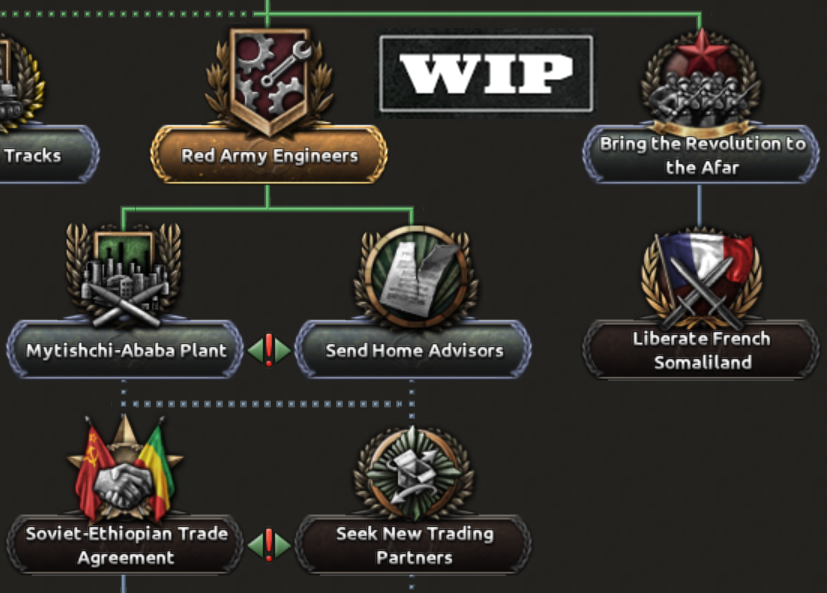
Loyalty to the Soviet cause will allow Ethiopia to Request Soviet Ships to help make the Red Sea a little more red. But, if the Ethiopian military administration has grown disillusioned with Soviet meddling in their affairs, Our Own Path will allow them to declare independence once again. However, the Soviets may not take too kindly to having their investment in Ethiopia thrown back at them.
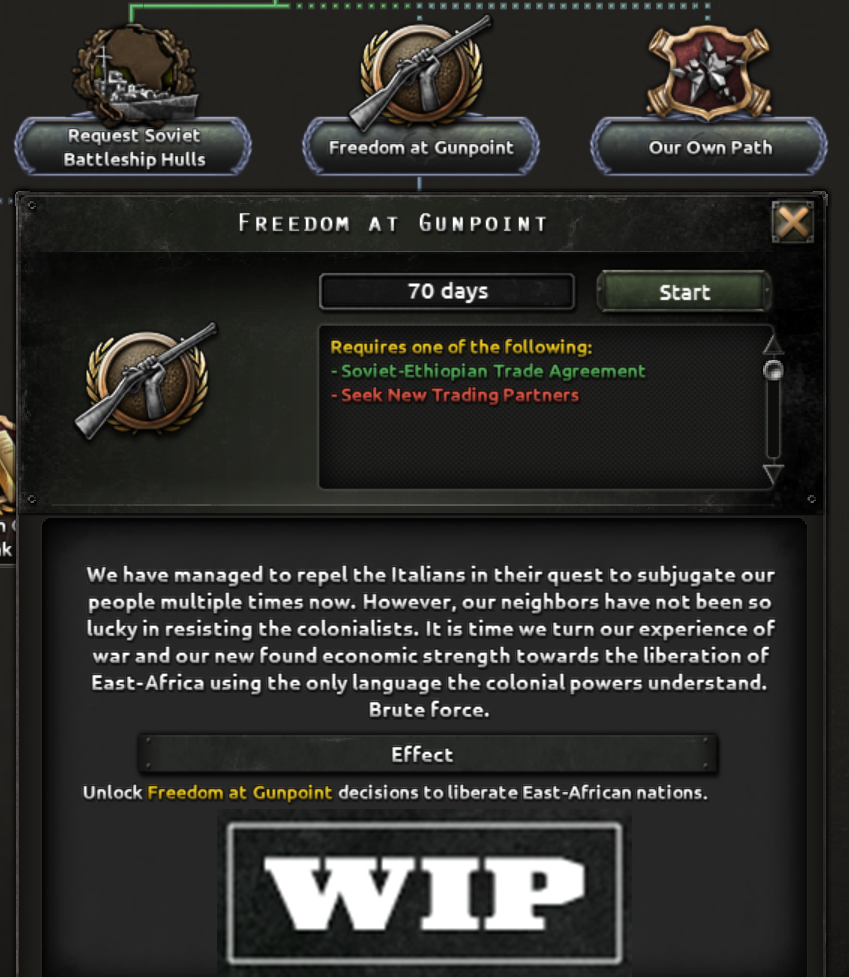
Either as an independent socialist republic or a Soviet backed one, East-Africa can be dangerous with all those imperialist powers nearby. Freedom at Gunpoint unlocks decisions for waging liberation wars against the neighboring powers to release their colonial territories. Don’t worry though, this doesn’t mean successfully marching from Addis Ababa to London in order to liberate Sudan. Once Ethiopia gains enough territory in the nation they are attempting to liberate, they will have the option to request a peace deal with the colonial power. With bigger enemies to deal with closer to home, they’re likely going to cut their losses.

This system for releasing African nations will come in very useful later on. But first of all, let's take a step back to A Callout to the World. We’ve seen how the military communists will lead the country if given a chance, taking it in a more Soviet inspired direction, but what about the Black Lions? Due to the decentralized, anti-fascist and anti-authoritarian values of the organization it seems they would take Ethiopia in a much different direction.
Taking the Callout to the World focus will unlock a number of advisors from across the world including socialists and anarchists such as Sylvia Pankhurst and Emma Goldman. Japanese Anarcho-Communism builds upon this further by recruiting the anarcho-communist Iwasa Sakutarō and the anarcho-syndicalist Ishikawa Sanshirō. Although be aware, these two supposedly really disliked each other, so you won’t be able to hire both of them at the same time. Following on from this, a choice must be made between International Brigades which creates a steady stream of manpower and war support for Ethiopia, or The Peoples Army which reforms the military by removing the conservative high-command and its associated penalties.
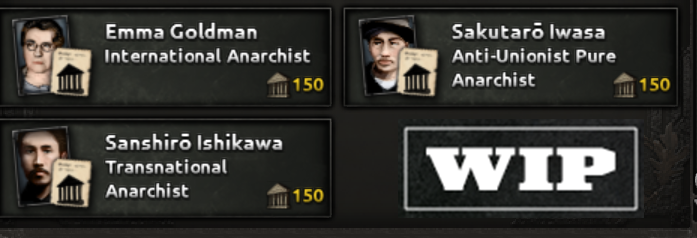
With the support of the anarcho-communists of the world, Ethiopia should finally be starting to halt the Italian advance. However, without the support of the League of Nations or a major power, any peace negotiations are going to be limited to essentially a ceasefire with the Italians. But much as we explored in the fascist branch, so long as part of Ethiopia survives, there is hope of restoring it fully someday.
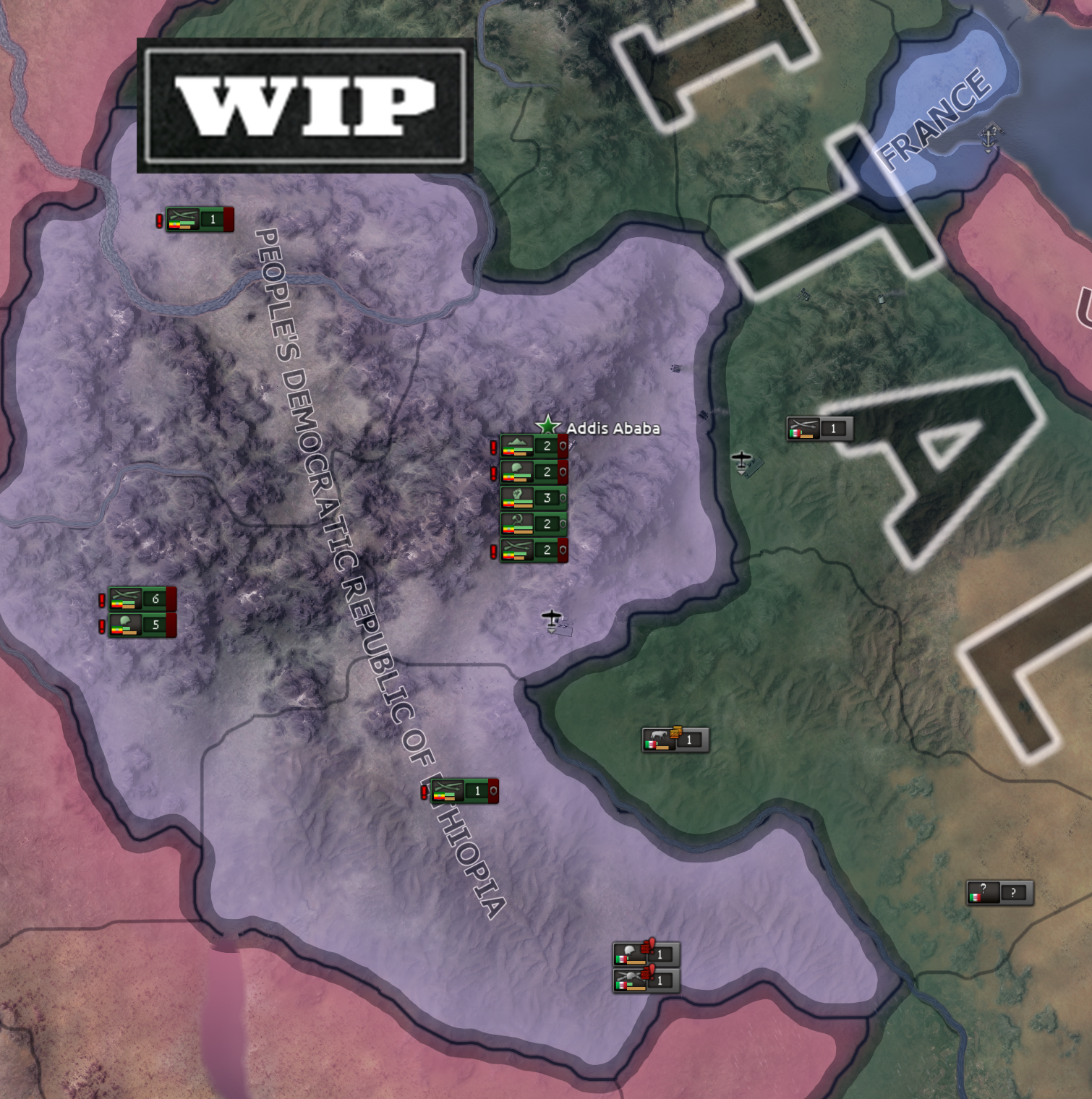
With an uneasy peace settling in with the Italians, attention can be turned to reforming what remains of the nation into a more economically prosperous and egalitarian society. The decisions made here will determine how far towards anarchism Ethiopia will go. Will it totally decentralize to become an anarcho-communist federation of loosely knit communities? Or will it remain somewhat centralized with a more traditional government to hold the republic together? These decisions will lead to various different leaders, including an anarchist council.
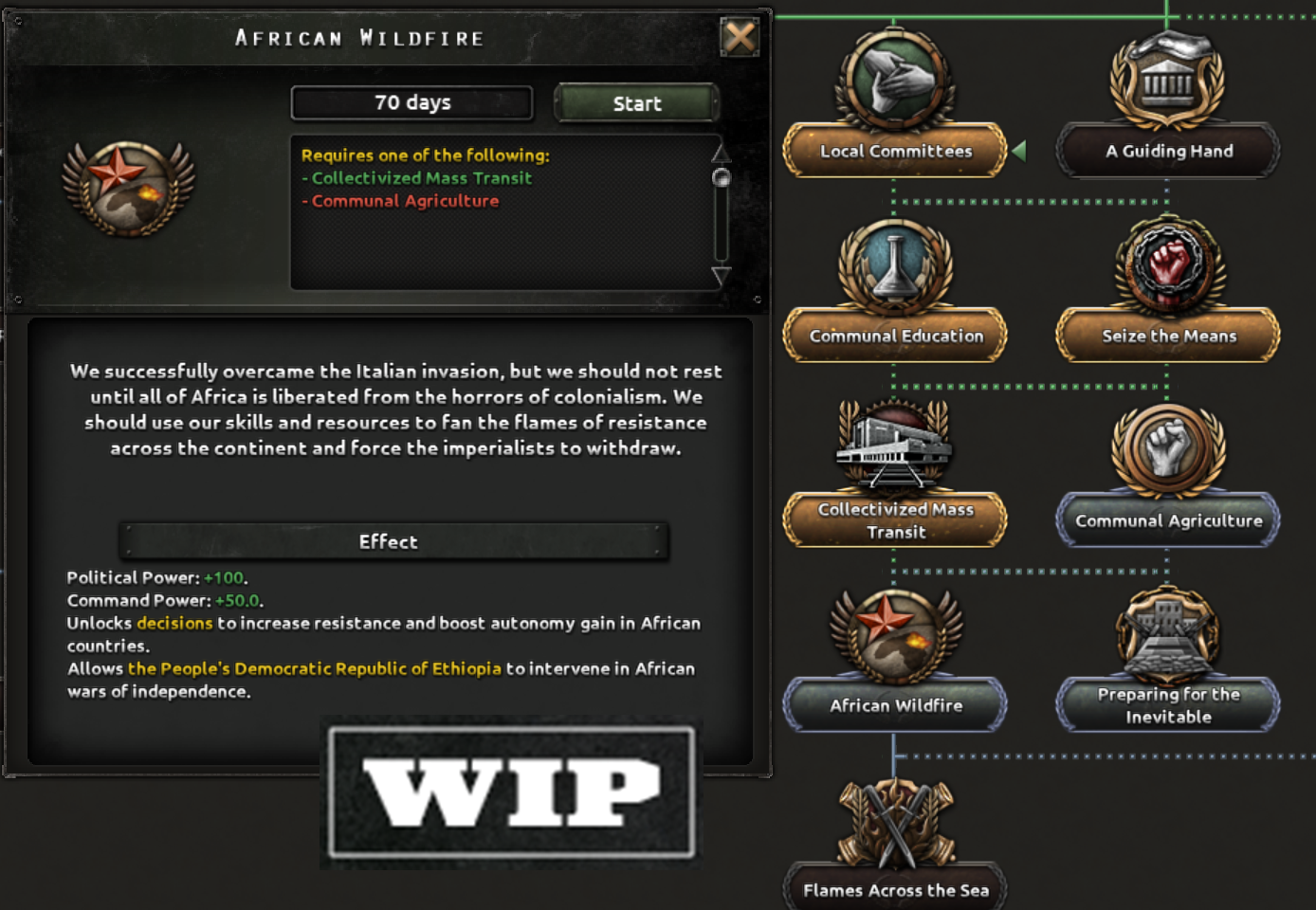
With Ethiopia reformed under a new political system, it’s time to start thinking about the enemies around East-Africa. In this sub-branch, the people of Ethiopia won’t be rolling into the surrounding areas in tanks to forcibly liberate their neighbors. Instead the African Wildfire focus will allow the revolutionary government of Ethiopia to funnel supplies into the neighboring states to increase resistance against their colonial overlords until they eventually break free on their own. You might have noticed that both sub-branches here offer means of freeing the people of Africa from colonial rule. And that’s because of the final section of this branch.
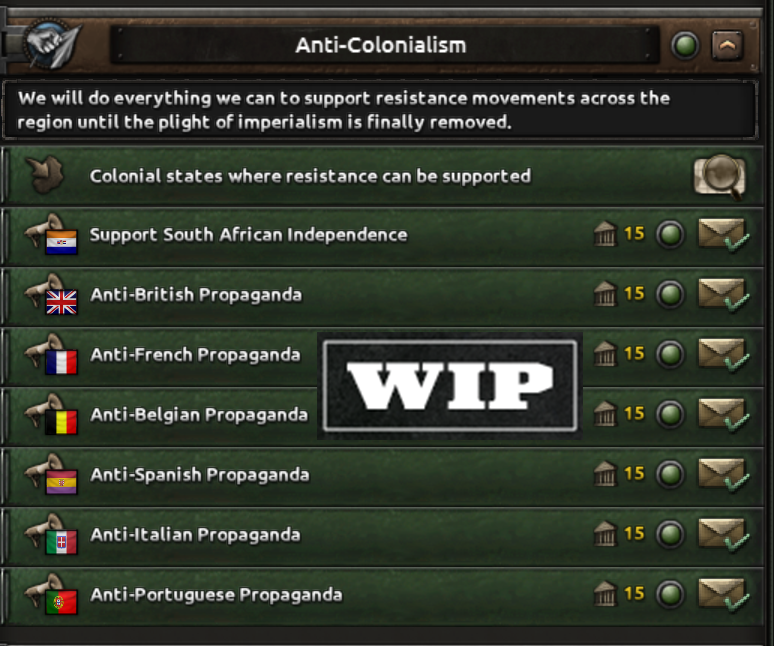
The African Union Both the anarcho-communist and Soviet sub-branches lead to this focus, The Organization of African Unity. In real life, the organization was established in 1963 with its headquarters in Addis Ababa. The organization strove to become a unifying force in African politics and ultimately became the African Union, a union somewhat similar to the European Union that many might be more familiar with. The roots of this pan-Africanism were already spreading in the 1930s and 1940s however.

Here, we explore those ideas from a more radical perspective. By becoming the founder of the Organization of African Unity, Ethiopia unlocks decisions to invite independent nations in Africa to join it. Each member gets a national spirit to signify their membership.
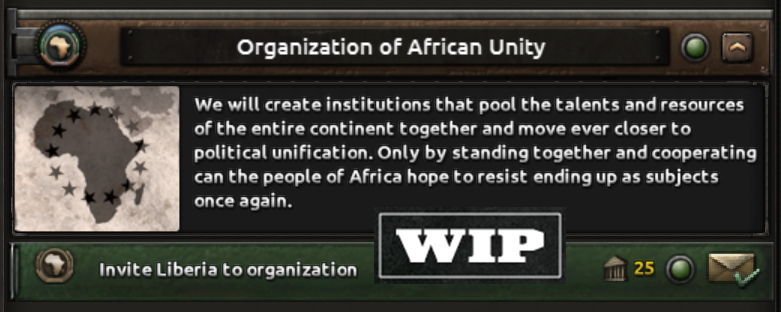
Here, we explore those ideas from a more radical perspective. By becoming the founder of the Organization of African Unity, Ethiopia unlocks decisions to invite independent nations in Africa to join it. Each member gets a national spirit to signify their membership.

Finally, as the various nations begin to pull together, Ethiopia’s final focus will become available, The African Union. Ethiopia will become the heart of the African Union with a beautiful new flag and the ability to integrate and core the territory of the Organization of African Unities member states. Hopefully it makes sense now why releasing African countries from colonial rule is so important in the run up to this part. While each individual country may be lacking in strength, together they can become a real menace in the Mediterranean and Indian Oceans which leads to really interesting clashes against the Allies and the Axis powers. Depending on the path taken to forming the African Union, the organization can feel very different. When coming at it from the Soviet sub-branch, it will feel a lot more like a ‘Soviet Union of Africa’ for example.
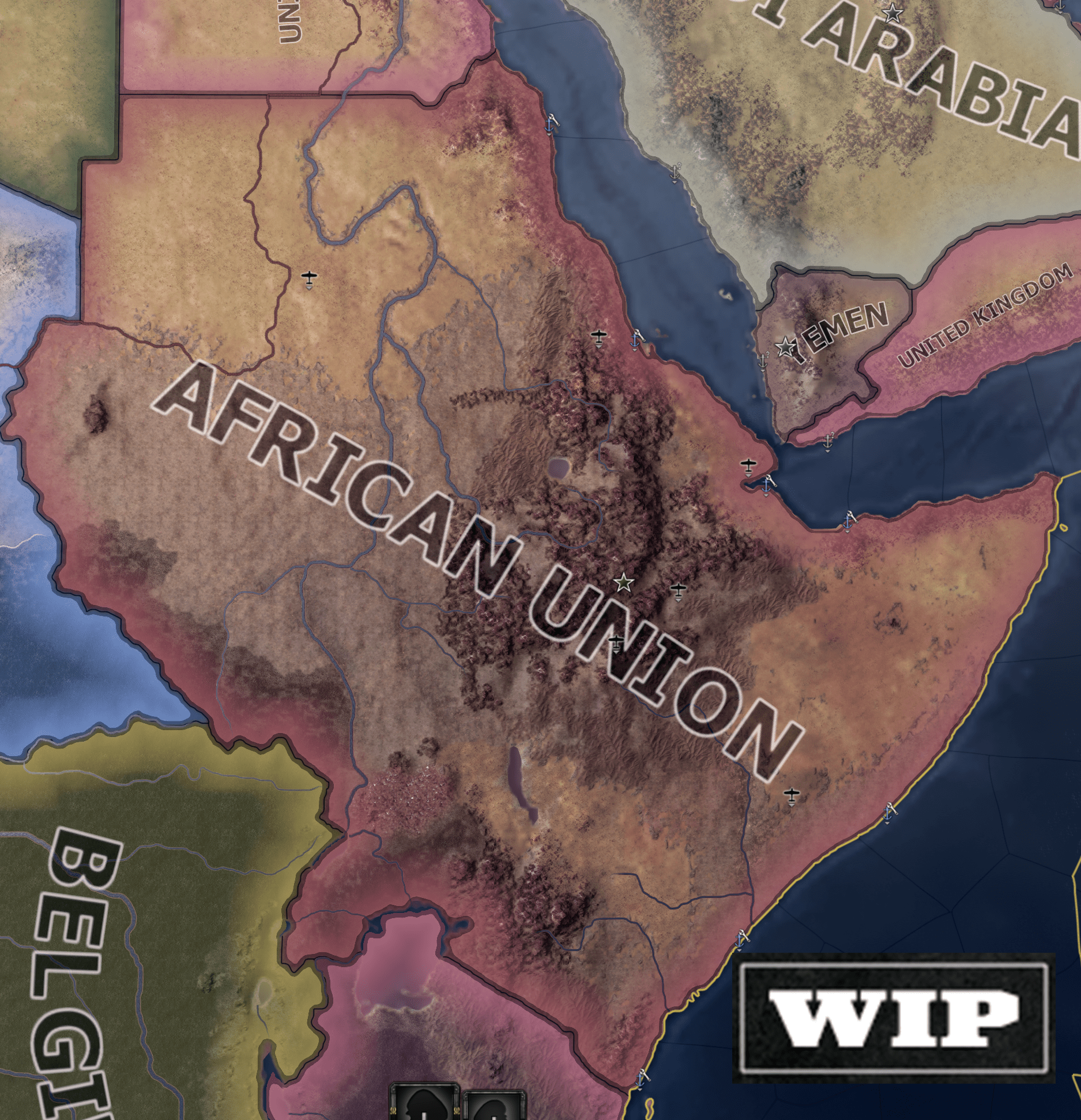
That’s all for this week folks. Remember all of this is still a work in progress and may be subject to change. But hopefully this has got you excited for Ethiopia’s revamped focus tree and its potential for fascinating alternate history. And I hope you’re excited for the next development diary two weeks from now which will be on the new plane designer. See you then!
{LINK REMOVED}Join the forum discussion here!{LINK REMOVED}



































